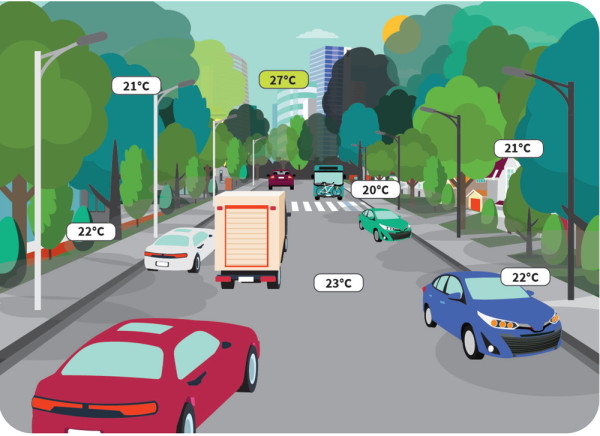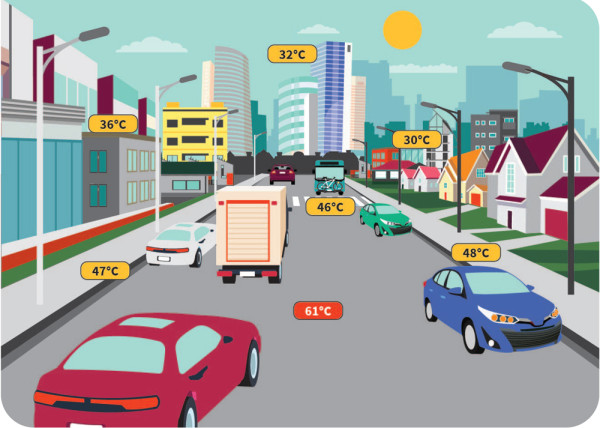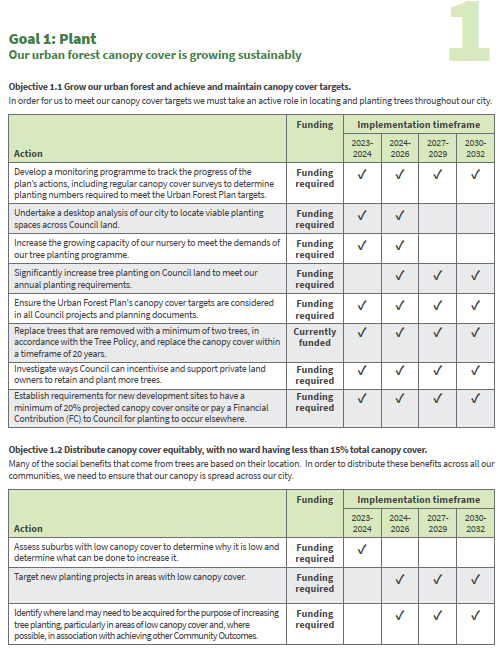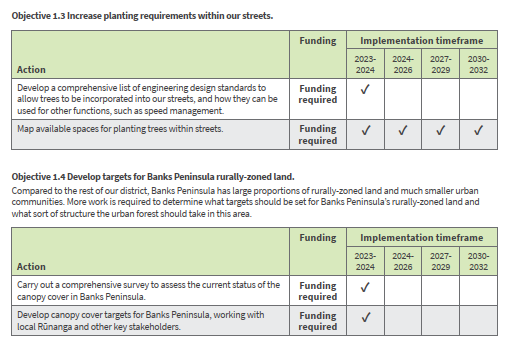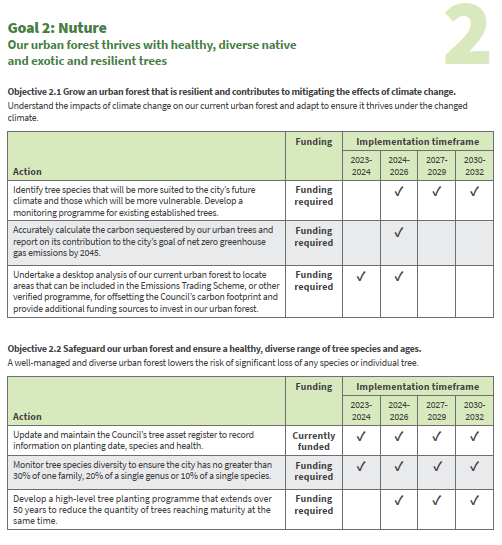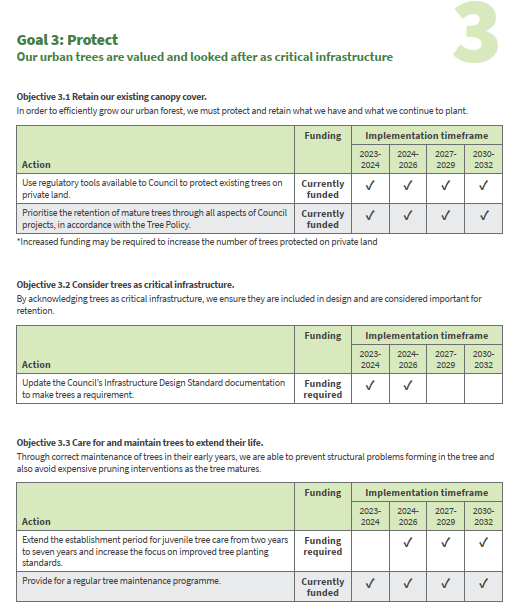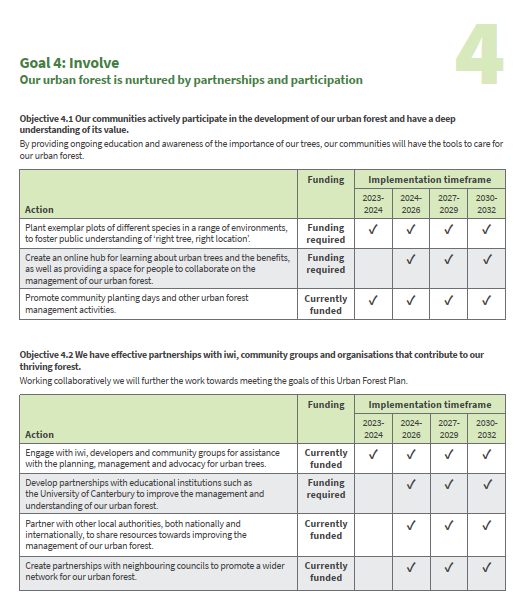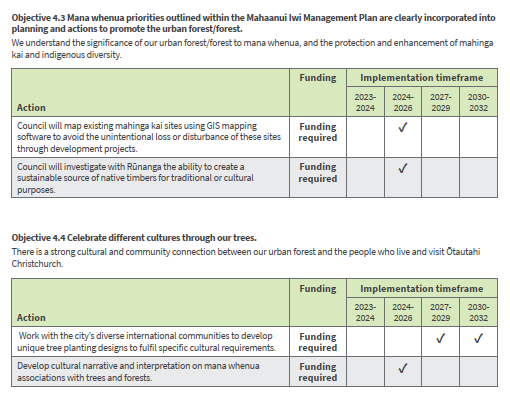Trees are on the job for us, 24 hours a day, seven days a week, working to improve our local neighbourhoods, our wellbeing and helping to mitigate the effects of our changing climate.
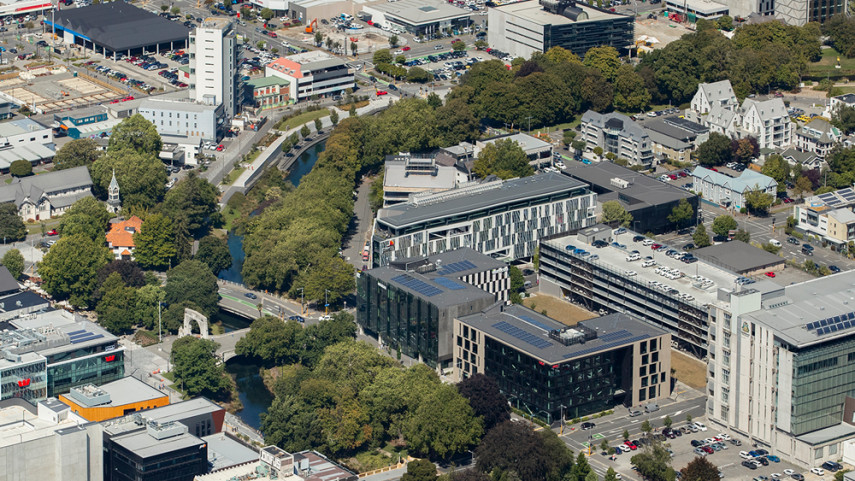
Share this
Consultation has now closed
Consultation on the Ōtautahi Christchurch Urban Forest Plan has now closed. People were able to provide feedback from 2 February to 6 March 2023.
During this time we heard from 290 individuals and groups. You can read their feedback [PDF, 76 MB] and also find out how this influenced the Council decision.
You can read the meeting minutes(external link), and also watch the decision being made. Christchurch City Council meeting 7 June 2023(external link).
What happens next?
The Urban Forest Plan [PDF, 4.2 MB] and its actions will be built into the programming and investment planning for the 2024-34 Long Term Plan. Actions that are currently funded will be implemented as per the timeframes in the plan.
Webinar recording - afternoon session(external link)
Webinar recording - evening session(external link)
Today’s trees – tomorrow’s forest
Urban trees are a key tool to help us meet the challenge of our climate and ecological emergency. They are central to enhancing our wellbeing and the pleasantness of our urban environment as well as providing a network of habitat for other wildlife.
Our Urban Forest Plan sets out how – over 50 years – we will grow our tree canopy and sustain a thriving urban forest of healthy, diverse and resilient trees. Achieving this will require strong action across Council activities and by the whole community – working together to nurture the forest, harnessing community participation and strengthening partnerships.
This Plan sets our direction and priority for planting, nurturing and protecting our city’s trees for now and the future. It forms a key component of the city’s response to climate change challenges and integrates with other Council plans directing the future intensification of urban form and a well-functioning city.
Why trees are important
Globally and within New Zealand, the number of adverse weather events is on the rise. While trees in general play an important role in reducing climate change through sequestering carbon, the benefits of urban trees have a much stronger focus on mitigating the effects of climate change.
Trees provide space for us to relax and play, a home for birdlife, insects and other wildlife, enhancement of our environment, a source of food to nourish and heal us, and improve our wellbeing. Just as roads, footpaths, drains, public buildings and recreational facilities are a part of our community’s infrastructure, so are trees.
Trees define our parks, neighbourhoods, and streets and are an essential part of Ōtautahi Christchurch’s character and identity. Many of us appreciated the value of trees in our lives during the Covid-19 pandemic, when getting outdoors and into green public spaces was important for our wellbeing. And, many people will recall how green and open spaces provided refuge and gathering places for residents and emergency services following the Christchurch earthquakes. Trees also bring many other benefits, such as reducing temperatures, aiding in stormwater management and filtering out air pollutants. However, for some, there are negative aspects to trees within our urban places. They create shade which, particularly in winter months, can be seen as a nuisance. Due to the high number of deciduous trees in the city, leaf drop is common resulting in occasional blocked drains and gutters. Mature tree roots can damage nearby infrastructure such as footpaths and underground pipes, however, this can be avoided through improving both the design and the tree species selected. Adhering to a rule of thumb of ‘right location, right plant, right function’ can avoid many of these problems. This means better integrated design and planning to select the right species and ensure the space is appropriate for the tree.
You can view the PDF version of the Urban Forest Plan here [PDF, 3.3 MB]
The Urban Forest Plan focuses on the growth and management of both public and private trees.
The Plan sets out how we can increase tree canopy cover across all of our urban area, over 50 years.
By meeting the goals within this plan we will make a significant contribution to mitigating the impacts of climate change, bring multiple benefits to the liveability of our neighbourhoods, our wellbeing and help to better sustain flora and fauna.
Vision and guiding principles
A vision: To preserve, value and grow our urban forest, to sustain Ōtautahi Christchurch.
By upholding these principles:
- Right location, right tree, right function – Trees are grown in locations that allow them to reach maturity and benefit the local environment.
- Working together – We collectively manage the urban forest on both public and private land to improve environmental, economic, social and cultural benefits.
- Guardianship – Our actions today will provide and protect a sustainable urban forest for future generations.
- For everyone – The urban forest will be distributed across the city to support the wellbeing of our residents and the natural environment.
Goals and targets
The Urban Forest Plan has four goals:
- Plant – Our urban forest canopy cover is growing sustainably (Goal 1).
- Nurture – Our urban forest thrives with healthy, diverse and resilient trees (Goal 2).
- Protect – Our urban trees are valued and looked after as critical infrastructure (Goal 3).
- Involve – Our urban forest is nurtured by partnerships and participation (Goal 4).
Targets for increasing tree canopy cover over 50 years take into account current land use and its capacity to sustain an increasing tree canopy. They are higher for open spaces and waterways, which generally have the greatest capacity for increasing canopy cover and are incorporated into Council planting programmes. Achievable targets for other land, including residential, commercial, industrial and streets, will encourage new tree planting while avoiding unreasonable constraints on their primary use.
Actions and progress
An Action Plan (Appendix 1) will drive progress towards achieving the goals and targets. As we work towards our goals, we will need to monitor and report on the status of the urban forest and the wider benefits to the city and our communities. The Action Plan requires the ongoing commitment of the whole of Council and the community to reach the canopy cover targets and the healthy urban forest we want for our city.
Benefits of urban trees
Distribution of canopy cover across the city at 2018/2019
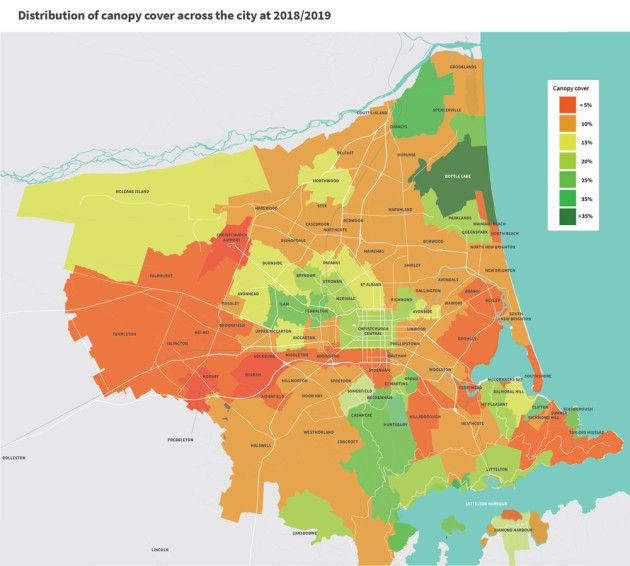
Our urban forest is a unique, complex natural system that extends across urban Ōtautahi Christchurch. It is a vital part of the green infrastructure that supports our built and natural environment. Of course, our district includes Horomaka Banks Peninsula, which requires a different approach to forest planning outside of the urban context.
This Urban Forest Plan has a strong focus on built environment areas, which relate more to the urban areas of the city and Banks Peninsula. A more targeted approach to the Banks Peninsula rural land will need to be developed (this will be completed in 2023/24).
The urban forest comprises native and exotic trees, other vegetation, and also the surrounding or supporting environment – air, soil, fungi and water. All the trees in our streets, parks and other open spaces, along our waterways and wetlands are part of our urban forest, as are the trees and vegetation we grow at home that provide us with shade, food and natural beauty. The urban forest includes isolated trees like those in shopping centre car parks, or small groups of trees in parks or reserves and forests, such as the remnant kahikatea trees at Pūtaringamotu Riccarton Bush.
Tree heritage
Indigenous flora and fauna has sustained mana whenua for hundreds of years, providing food, fibre, building materials, fuel, medicine and other necessities. The relationship between mana whenua and indigenous biodiversity has evolved over centuries and is an important part of Ngāi Tahu culture and identity.
The forest is central to mana whenua values. A well- managed native forest also has the potential to provide high quality timbers for traditional purposes. Access to the forest enables traditional knowledge to be retained and passed on to future generations.
While this is the first Urban Forest Plan for Ōtautahi Christchurch, the concept of planting our urban areas is a long-established practice (which is reflected in the number of significant trees). Our city’s urban forest story has been influenced by natural events, settlement aspirations (milling and beautifying), and native and exotic diversity.
The vision of organisations such as the Christchurch Beautifying Association, successive Council agencies and the citizens of Ōtautahi Christchurch, have culminated in the area of urban forest cover being more than 1000 times greater today than it was in the mid-1800s. Though dominated with exotic tree species, native forests have had a renaissance in recent years, in particular within restoration planting projects.
Trees and our city
Canopy cover is the area of vegetation over 3.5 metres in height, proportionate to the land area, determined through the use of aerial photography and LIDAR. It is often expressed as a percentage of the total city’s area and is the most commonly used measure to quantify an urban forest.
Measuring our canopy cover helps us understand our urban forest coverage, how it has changed and how it compares to other New Zealand and overseas cities. This in turn helps to inform what canopy cover targets we set for our city and measure the benefits it provides.
The differences in geography, land use, climate, natural vegetation and soils all affect a city’s urban forest. Our city is located on a largely flat plain, in an area that was predominantly grass and wetlands at the time of European colonisation. However, prior to human arrival the area of modern day Ōtautahi Christchurch would have been a much more forested landscape interspersed with swamps
and shrub land.
Our last two canopy cover surveys (2015/16 and 2018/19) show a decrease of approximately 2% (from 15.59% to
13.56%). As the survey only accounts for trees that are over 3.5 metres in height, it excluded many of the tree planting projects that had been undertaken in the five years prior. Regardless of this, it reflects a trend of declining canopy cover which we would like to see reversed.
Our landscape makes it more challenging for us to naturally reach canopy cover similar to other cities, such as Auckland (18%) and Wellington (30%), which were primarily forested areas prior to European colonisation. There is very little natural generation of tree canopy in Ōtautahi Christchurch – for trees to grow or establish, intervention is normally required.
Seeking diversity
Range of species
Tree species' diversity is important to maintain a healthy tree population, and biodiversity within our ecology. The greater the diversification, the more resilient our urban forest will be to threats, particularly the effects of climate changes and pests and diseases. In line with best practice urban forestry to achieve diversity of tree species across the city, there should be no more than 30% from one family, 20% from a single genus or 10% of trees from a single species. We must also take steps to protect the natural diversity of our local indigenous fauna through the use of locally-sources plants.
Trees of various ages
Age diversity is important for maintaining a relatively stable urban forest population over time and reflects a natural forest environment. This prevents the tree population from declining, deteriorating and having to be replaced around the same time, which can have significant impacts and costs.
Currently 52% of our trees listed in the Christchurch City Council database are still in their growing phase (juvenile and semi-mature) and 48% have reached maturity. This means we have an ageing tree population that will require a significant and consistent tree planting programme.
Mix of heights
A range of tree sizes provides scale and interest against the built environment. With bigger canopies and root systems, larger trees maximise benefits, including more carbon sequestration, stormwater management and shade. While our urban forest canopy cover prioritises large trees, smaller trees are equally an important element of urban design where there is restricted space for greening (e.g. a risk of conflict with overhead infrastructure or buildings).
The survey of tree canopy cover shows that in Ōtautahi Christchurch more than 38% of our trees are over 12 metres tall. The height of the tree canopy varies between approximately 3.5 metres to over 45 metres, with many of the tall trees found in clusters throughout the city (e.g. plantation forests, Pūtaringamotu/Riccarton Bush, shelterbelts, parks).
Taking a strategic view
The Urban Forest Plan is part of wider city planning for how we make use of land and waterways, and provide infrastructure to live, do business, move around, enjoy the outdoors and respect mana whenua values for whenua and wai. How, what and where we plan affects individual and community wellbeing, and our resilience to the impacts of climate change.
The Urban Forest Plan underpins the Council's Strategic Priorities of 'Meeting the challenge of climate change through every means available' and 'Enabled active and connected communities to own their futures'. It supports our key Community Outcomes of Resilient Communities, Liveable City, Healthy Environment, and Prosperous Economy.
The principles and policies set out in the Ngāi Tahu Mahaanui Iwi Management Plan 2013 are reflected in the Urban Forest Plan's actions and objectives. Also, there is alignment with key Council and sub-regional plans already completed or underway, including:
- Draft Ōtautahi Christchurch Plan and draft Ōtautahi Christchurch Transport Plan (and Greater Christchurch spatial and transport plans in development)
- Kia tūroa te Ao Ōtautahi Christchurch Climate Resilience Strategy
- Te Haumako Te Whitingia Strengthening Communities Together Strategy
- Biodiversity Strategy
- Tree Policy
- Ōtakaro Avon River Corridor Regeneration Plan
Actions in the Urban Forest Plan will inform business cases and investment planning for Council work programmes and projects through annual and long-term planning processes.
Trees as part of core infrastructure
We need to take an integrated approach to infrastructure provision. Urban forest requirements need to be accommodated and treated on an equal par with other infrastructure (such as footpaths, pipework and cables within the road corridor) when planning, designing and developing our city.
Increasingly, due to urban intensification, there is reduced space for gardens and trees on developed residential land and narrower, more congested streets. We need to take opportunities to embed development of our urban forest into urban design and regeneration so that it is compatible with public and private land uses.
Competition for space
Trees require space to grow, both above and below ground. As our population grows there is increasing pressure on how we use land – for housing, recreation, infrastructure or commercial development. Planting more trees will have to compete in this environment.
For the city to achieve its targets for tree canopy cover, the Council will need to maximise use of existing public land as well as considering acquisition of suitable land for planting trees.
Our current estimated residential population is 395,000. This is projected to increase by 21% to approximately 480,000 by 2050. As land is developed to accommodate this growth, our urban forest will be vulnerable to removal, as there are currently limited mechanisms to protect trees on private land.
Damage to adjacent infrastructure and property
We need to provide suitable spaces for trees to grow, so that we avoid damage to adjacent infrastructure and property (that often results in tree removal) and the health of the tree is optimised. This includes minimising conflicts with above and below ground infrastructure and pruning to improve sightlines or for crime prevention purposes. It also means that the pits in which new trees are planted suit the specific tree and its surrounding environment, including improving soil moisture and water quality through the use of permeable surfaces. Updating the Council’s Infrastructure Design Standards and better coordination of below- and above-ground infrastructure works are important ways to better manage and avoid negative impacts of tree planting on public land.
Trees, especially large ones, have the potential to be perceived as a nuisance due to issues such as blocked views, leaf and fruit/nut debris, cracked paving and excessive shading. It is important that we engage with the community not only about the critical benefits of trees, but also about how we manage our urban forest in the future, to ensure a liveable, sustainable Ōtautahi Christchurch.
Equitable tree coverage
Building sustainable communities needs to be at the forefront of our thinking. Currently our urban forest is not spread across our communities evenly, so the benefits are not able to be shared by everyone to the same extent. In part, this is due to land use zoning, where often the areas with lower tree canopy cover are in, or near, commercial or mixed-use zones with little open space. There is also an
international trend that shows an imbalance of canopy cover between wealthy and economically deprived areas, this has been reflected in the recent canopy cover surveys within Christchurch with wealthier suburbs having higher canopy cover. As we increase tree canopy cover across our district, we will need to prioritise neighbourhoods which are lacking trees and support businesses and communities to take stewardship of their role in contributing to urban forest growth.
Changing climate conditions and impacts on the urban forest
Over time, our summers are becoming hotter, drier and longer, and our winters shorter and milder. We are likely to experience more extreme weather events. Sea level rise and changes to ground water levels have an impact on what trees will be suitable in coastal areas. With the changing climate, some tree species that we’re used to seeing in Ōtautahi Christchurch may no longer be suited to our environment. This will not only have a significant impact on indigenous biodiversity, but will have a particular impact on mana whenua and their ability to maintain ancestral links with indigenous biodiversity and mahinga kai. A warmer climate can bring new pests and diseases. A diversity of species and healthy trees will create an urban forest that is more resilient to these pests and diseases. Natural regeneration is also important in building genetic resistance to disease in native and exotic tree species.
The Council has set a target of Ōtautahi Christchurch having net zero greenhouse gas emissions by 2045 (with separate targets for methane) and to halve our district’s emissions by 2030, from 2016-17 levels. Our district emitted around 2.72 million tonnes of carbon dioxide equivalent (tCO2-e) in FY2018/19. When forestry is taken into account, total net greenhouse gas emissions were around 2.53 million tonnes of tCO2-e. While the government and Council are currently focused on reducing our emissions, we will still need to substantially increase the amount of carbon we sequester to achieve our net zero goals through programmes such as the government’s Emissions Trading Scheme. Trees are one of the most cost-effective ways to do this, and provide numerous co-benefits for the community and the environment at the same time.
Reducing urban heat islands
The heat island effect is due to the large amount of human-made materials, such as roads and buildings, which absorb and retain heat for longer than natural surfaces, making cities much hotter than surrounding areas. Trees are able to cool their surrounding environment through shading and transpiration (releasing water from their leaves into the air) which in turn reduces the surface and air temperature. Furthermore, shading provided by trees has been shown to extend the life of infrastructure such as asphalt. Due to climate change, average maximum temperatures in our city will be up to 3-4°C hotter by the end of this century, and if large emission reductions are not achieved the occurrence of individual heat waves is potentially much higher. As these temperatures increase, the ‘heat island effect’ is likely to impact on urban centres even more.
Increase in storm events
Climate change won't just mean increasing temperatures - it will also lead to more frequent droughts, interspersed with more frequent storm events and extreme rainfall. This is likely to add increased pressure on existing stormwater systems across the district.
Trees can help absorb and retain water during rainfall, reduce strain on stormwater networks and decrease the risk and duration of surface water flooding. Trees also help prevent erosion of hillsides, which is predicted to increase with more droughts, coupled with sudden extreme rainfall events. Through careful infrastructure design of rain gardens and basins, trees can be incorporated in to stormwater management systems and contribute to addressing a range of climate change impacts.
Readings show, on a 30 degree day in Christchurch, cars and hard surfaces like roads and footpaths, will reach temperatures in excess of 50 degrees. Under trees, those same surfaces can be more than 20 degrees cooler.
We want all people and groups to have a sense of ownership over the long-term wellbeing of our urban forest, so we need to continue to increase the opportunities for local communities to be part of the management and growth of our urban forest.
Trees take time to mature and our planting programme needs to allow for this. An increase in tree planting that can be sustained over the long term will avoid having large proportions of our trees reaching the end of their lifecycle at the same time.
We also need to be more strategic in our planning to ensure that trees are planted appropriately, to suit their environment and help achieve the Council’s other plans and strategic objectives, such as improved neighbourhood amenity and safety. Our Tree Policy provides clear guidance in managing Council trees to meet community aspirations and service requests. It also provides clarity for decision making, while maintaining consistency in the approaches taken by Council and our contractors. This ensures that we adhere to best practice in tree management and maintenance, which maximises the health of the tree and minimises exposure to risks.
We need to create suitable planting sites and select species that are able to thrive in their immediate environment, and suit future challenges such as climate change impacts. In recent years, native species have been planted, mostly as part of ecological restoration programmes in regional parks and along waterways. Planting more native trees in high-use areas, such as local parks and streets, will not only increase their presence in the landscape, but also the resilience of the urban forest whilst maintaining the large deciduous landscape that Ōtautahi Christchurch is known for.
Our urban forest canopy cover is growing sustainably
Sustainable growth needs to be appropriate for the land type and take into account the lifecycle of the trees. In order for us to grow our canopy cover we need to take a two-pronged approach. First we need to retain what is already there; and second, we need to plant more trees.
The retention of our trees is covered by Goal 3 and focuses on both protecting our trees and also improving their status to ensure they are retained during development.
Next, the growth of our urban forest requires an increase in tree planting across the city. We have set targets to increase canopy cover throughout the district across all land use types. If we meet these targets, we would have a city-wide canopy cover of >20% by 2070.
Planting within our streets will be one of the more challenging environments by will also result in the largest benefits to the city. A strong focus on roadside tree planting and taking innovative approaches to planting trees as part of local street renewal projects (e.g. Greening the East) will help the city to reduce air pollution, heat island effects, manage stormwater and support green corridors.
We will review our canopy cover targets as Ōtautahi Christchurch develops and changes over time, or to meet any government policy direction, and as new research becomes available to ensure our urban forest is sustainable and best meet our needs.
Finally as a large portion of the Banks Peninsula is rural land, and only a small portion is made up of urban communities, we need to develop an appropriate target for rurally-zoned land.
To achieve Goal 1, we need to:
- Grow our urban forest and achieve and maintain canopy cover targets;
- Distribute canopy cover equitably, with no ward having less than 15% total canopy cover;
- Increase planting requirements within our streets; and
- Develop targets for Banks Peninsula rurally-zoned land.
Table 1: Targets for canopy cover by land use
| Land use type | Current canopy cover 2018/19 | Targeted canopy cover by 2030 | Targeted canopy cover by 2070 |
|
Open spaces |
23% | 25% | 40% |
| Street | 8% | 9% | 15% |
| Waterway | 21% | 30% | 75% |
| Residential | 13% | 15% | 20% |
| Commercial (including industry and mixed use) | 4% | 5% | 10% |
| Rural (excluding Banks Peninsula) | 11% | 12% |
15% |
Our urban forest thrives with healthy, diverse and resilient trees
With a healthy, diverse (including both native and exotic trees) and well-distributed urban forest we will meet the needs of both the built and natural ecosystem for generations to come.
Through the creation of suitable planting sites (right location) and the selection of species (right tree) that are able to thrive in their immediate environment, we will have a more resilient urban forest that is better equipped to meet future challenges (right function).
Planting more native trees in public space enhances Ōtautahi Christchurch's indigenous biodiversity and sustains mahinga kai, as well as providing a food source and movement corridors for indigenous wildlife.
A well-managed and diverse urban forest will safeguard against the risk of large-scale loss from the introduction of pests and/or diseases.
To achieve Goal 2, we need to:
- Grow an urban forest that is resilient and contributes to mitigating the effects of climate change;
- Safeguard our urban forest by ensuring a healthy, diverse range of tree species and ages;
- Base tree selection on species' needs and and attributes that benefit the immediate environment;
- Increase the visibility of native tree species and create ecological corridors; and
- Select and design planting sites to enable a tree to reach maturity and minimise conflicts with the surrounding area.
Our urban trees are valued and looked after as critical infrastructure
Protecting trees can come in many different forms from regulatory protection, such as trees listed in the Christchurch District Plan, through to improving the status of trees to see them treated with equal importance as other critical infrastructure.
Often when areas are developed tree retention is not considered to be a priority, even though, unlike most assets, a mature tree is not able to be replaced like for like (they take time to grow).
Another form of tree retention is extending the life of our existing trees. This can be achieved through improved maintenance programmes which focus on creating the correct tree structure to ensure they are less prone to storm damage or collapse. Mulching trees and proteceting them during nearby construction work will also help extend the life of existing trees.
Through prioritising the importance of trees, and improving the way we protect and maintain them, we will remain more of our existing trees and those we continue to plant.
To achieve this Goal 3, we need to:
- Retain our existing canopy cover
- Consider trees as critical infrastructure
- Care for and maintain trees to extend their life
Our urban forest is nurtured by partnerships and participation
We are proud of our Garden City identity, but we need to do more to ensure that it reflects our natural environment, culture and community needs. The Council plays a leading role in growing and managing our urban forest, but success also requires collaboration and partnerships with mana whenua, community groups and property owners.
We need to recognise the role of mana whenua as kaitiaki of the urban forest and work towards enhancing and protecting indigenous biodiversity, including sustaining mahinga kai.
Working collaboratively we will further the work towards meeting the goals of this Urban Forest Plan. Through greater engagement with all plans of our communities - many of whom are already working towards the vision and goals of this plan - we will look for opportunities to collaborate in the management and growth of our urban forest.
By providing ongoing education and awareness of the importance of our trees, our communities will have the tools to care for our urban forest. We want all people and groups to have a sense of ownership over the long-term wellbeing of our urban forest.
There is a strong cultural and community connection between our urban forest and the people who live in and visit Ōtautahi Christchurch. We understand the significance of our urban forest/forest to mana whenua, and the protection and enhancement of mahinga kai and indigenous diversity.
Together, we will create an environment where the biodiversity, landscape and special character of our urban forest is valued, protected and cared for.
To achieve Goal 4, we need to:
- Encourage communities to actively participate in the protection and development of our urban forest and have a deep understanding of its value;
- Work with iwi, community groups and organisations that contribute to our thriving forest;
- Ensure mana whenua priorities are clearly incorporated into planning and actions to promote the urban forest/forest to mana whenua; and
- Celebrate different cultures through our trees.
The detailed Action Plan (see Appendix 1) sets out ongoing, immediate and longer-term actions to maintain our urban forest and increase the amount of tree canopy cover. The actions to achieve each of our four goals are set out sequentially, taking a strategic approach to maintaining and growing our urban forest over time.
Most of the funding required to meet the targets of the Urban Forest Plan will go into planting trees. Studies have shown that, for every $1 spent on tree planting, a return of $2.25 per year can be achieved through benefits such as supporting stormwater management and sequestering carbon.
- Some of the actions are already funded under existing projects and Council operations.
- Actions that require additional investment in new projects or operations are identified and will need to be considered as part of long term and annual budgets’ planning processes.
- To be successful, we need to fund a large-scale tree planting programme across the city.
- Ongoing maintenance, such as pruning throughout the life of the tree, also incurs additional costs.
Planting in existing suitable locations can be relatively inexpensive and complement outcomes such as increasing safety and managing stormwater. However, when it comes to planting in areas such as road corridors without sufficient grass berms, the cost can be higher but the benefits also much greater.
Cross-Council actions will lead the growth and management of our urban forest. The Urban Forest Plan’s success also, crucially, requires collaboration and partnerships with mana whenua, community groups and landowners. Volunteer support will be a valuable contribution to us delivering some of the actions required.
Growing and nurturing our urban forest will also require continued support from a mix of sources, including developers, property and business owners, and through mechanisms such as the proposed collection of Financial Contributions for tree planting from landowners who do not replace felled trees as part of site developments. Trees being planted and well-maintained on private property, and in new developments, add benefits to the surrounding
environment.




